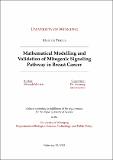| dc.contributor.author | Meher, Abinash | |
| dc.date.accessioned | 2023-09-18T18:46:26Z | |
| dc.date.available | 2023-09-18T18:46:26Z | |
| dc.date.issued | 2023-09-18 | |
| dc.identifier.citation | Meher, Abinash. Mathematical Modelling and Validation of Mitogenic Signaling Pathway in Breast Cancer [A thesis submitted in partial fulfillment of the requirements for the degree of Master of Science in Bioscience, Technology, and Public Policy]. Winnipeg, Manitoba, Canada: University of Winnipeg, February 2022. DOI: 10.36939/ir.202309181334. | en_US |
| dc.identifier.uri | https://hdl.handle.net/10680/2110 | |
| dc.description.abstract | Applied Mathematics is becoming an integral part of predicting disease progression, including cancers. Mathematical models can be used to test novel hypotheses, develop optimized treatments schema and personalised therapies, and predict the outcomes. Remarkable advancements have been made in treating cancers, especially breast cancers. The phenomenal progress in computational capacities has helped make whole-genome sequencing rapid and affordable, enabling precision cancer therapy. There are many molecular drivers of breast cancer. Some of them define the breast cancer sub-types. The presence of estrogen receptor (ER, progesterone receptor (PR) and/or human epidermal growth factor 2 (HER2) or their absence defines the breast cancer subtypes and their treatment regimen. About 70% of the breast cancer diagnosed are ER/PR positive and are also known as hormone receptorpositive (HR+) breast cancer. The prognosis and treatment response of HR+ breast cancer is good for patients undergoing endocrine therapy. Despite the better prognosis of HR+ breast cancer, the recurrence rate and resistance to endocrine therapy is observed in many HR+ breast cancer cases. The resistance to endocrine therapy and recurrence is partly attributed to the activation of the insulin pathway and independent of HR+ breast cancer cells on ER pathway for their growth. Earlier, the crosstalk between insulin and ER pathways was demonstrated. N-myristoyltransferase (NMT) exists in human in two isoforms (NMT1 and NMT2) that catalyzes myristoylation reaction. Recent research from out laboratory has shown that NMTs are vital players in the pathogenesis of JR+ breast cancer. Furthermore, it was also demonstrated from previous studies from our laboratory that NMTs are downstream targets of insulin and ER pathways. In this thesis, I have designed mathematical models using differential equations to study the activation of the insulin pathway and its effect on NMT. The mathematical modeling incorporated the partition of cellular organelles and the sequential flow of information with cascades of equations representing signaling reactions. The activated mathematical model was designed by activating the insulin receptor (IR) or insulin-like growth factor receptors (IGF1R) and compared with the control model. The mathematical models were validated by wet-lab experiments. The HR+ breast cancer cells, MCF7 cells, were treated with insulin of IGF1 for the short-term and long-term. The status of the pathway proteins in terms of expression, localization and activity were determined by cell fractionation and Western analysis. The results revealed the correlation between the differential expression patterns of NMT and the proliferation of MCF7 cells when the insulin pathway was activated by insulin or IGF. The mathematical modeling was validated by simulations and data fittings. The results demonstrated that differential equation based mathematical modeling could predict the NMT related oncogenic changes in ER+ breast cancer cells. | en_US |
| dc.description.sponsorship | University of Winnipeg; Cancer Care Manitoba | en_US |
| dc.language.iso | en | en_US |
| dc.publisher | University of Winnipeg | en_US |
| dc.rights | info:eu-repo/semantics/openAccess | en_US |
| dc.subject | Cancer | en_US |
| dc.subject | Breast Cancer | en_US |
| dc.subject | Mathematical Modelling | en_US |
| dc.title | Mathematical Modelling and Validation of Mitogenic Signaling Pathway in Breast Cancer | en_US |
| dc.type | Thesis | en_US |
| dc.description.degree | Master of Science in Bioscience, Technology, and Public Policy | en_US |
| dc.publisher.grantor | University of Winnipeg | en_US |
| dc.identifier.doi | 10.36939/ir.202309181334 | en_US |
| thesis.degree.discipline | Bioscience, Technology, and Public Policy | |
| thesis.degree.level | masters | |
| thesis.degree.name | Master of Science in Bioscience, Technology, and Public Policy | |
| thesis.degree.grantor | University of Winnipeg | |

